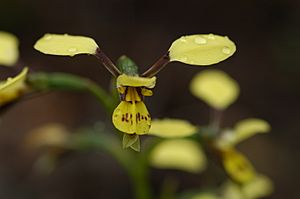Early doubletail facts for kids
Quick facts for kids Early doubletail |
|
|---|---|
 |
|
| Diuris praecox in the Munmorah State Conservation Area | |
| Conservation status | |
| Scientific classification | |
| Genus: |
Diuris
|
| Species: |
praecox
|
The Diuris praecox, often called the early doubletail, is a special type of orchid. It is also known as the Newcastle doubletail or rough doubletail. This beautiful flower grows only in New South Wales, Australia. It has two or three leaves that look like grass. Its flowers are usually light yellow with a few dark brown spots. Sadly, this orchid is currently at risk because of cities growing bigger.
Contents
Meet the Early Doubletail Orchid
What Does It Look Like?
The early doubletail orchid grows from a tuber (a bit like a potato). It is a perennial plant, meaning it lives for more than two years. It has two or three long, thin leaves, about 15 to 40 centimetres (6 to 16 inches) long. These leaves are often folded in half lengthwise.
Each plant can have six to ten flowers on a stem. The stem can grow to be 20 to 40 centimetres (8 to 16 inches) tall. The flowers are about 2 to 2.5 centimetres (0.8 to 1 inch) wide. They are mostly pale yellow. You might see some dark brown marks near the base of the flower's main parts. The petals stand up, and the lower parts of the flower (called sepals) point downwards. This orchid usually blooms from July to early September.
Why Is It Special?
This orchid was first officially named in 1991 by a botanist named David Jones. He found a sample in the Glenrock State Conservation Area. The name praecox comes from a Latin word. It means "too early ripe" or "premature." This name was chosen because this orchid flowers earlier than other similar orchids.
Where Does It Live?
The early doubletail orchid grows in forests near the coast. You can find it between Bateau Bay and Smiths Lake in New South Wales. It is especially common in the Munmorah State Conservation Area and Wyrrabalong National Park. It likes to grow in these specific coastal areas.
Protecting This Orchid
The Diuris praecox orchid is listed as "vulnerable." This means it is at risk of becoming extinct if we don't protect it. Both the Australian Government and the New South Wales government have laws to help protect it.
The biggest threats to this orchid are:
- Urbanisation: This is when towns and cities expand, taking away the orchid's natural home.
- Weed Invasion: Other plants (weeds) can grow and take over the areas where the orchids live.
- Track Expansion: New tracks or paths can damage their habitat.
- Recreational Use: Activities like bushwalking or off-road driving can also harm the plants.
Protecting these special places helps the early doubletail orchid survive.


